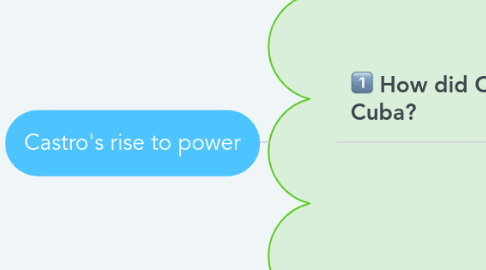
1. How did Castro take control of Cuba?
1.1. In April 1898, during the Cuban independence war from Spain, USA joined the war on Cuban side.
1.1.1. Spanish relinquished their hold on Cubam but their troops were replaced by US ones.
1.2. US corporations were heavily invested in Cuba and worried about the aftermath of their independence from Spain.
1.2.1. US Public grew more supportive on the military action in Cuba after the USS maine was allegedly blown by Spanish.
1.3. Cuba gained independence from Spain in 1968, but USA granted the formal independence only in 1902.
1.3.1. The 1901 Platt Amendment gave the USA the right to intervene militarily in Cuba whenever it wanted.
1.3.2. Election were rigged in favour of pro-US candidates.
1.3.3. US corporations trade with US created a gap between wealthy minority and impoverished majority.
1.4. "Sergant's Revolt" of 1933 involved a group of army officers led by Batista arresting their own officers.
1.4.1. This was a result of Gerardo Machados brutal dictatorship of 1920s
1.5. Batista gained the support of a wide range of Cuban society due to his origins and the fact that he was non-white ruler and he became president in 1940
1.5.1. The Second World War was lucrative for Cuba.
1.6. In 1944 Batista was constitutionally obliged to step down as president
1.6.1. His chosen successor lost the election to Grau, hence Batista emigrated to USA with a large portion of Cuban treasury
1.7. Partido Ortodoxo was founded in 1947 and it attracted Fidel Castro
1.8. Grau abandoned socio-economic reforms in favour of ensuring the support of welathy businessmen and US corporations
1.8.1. His successor Carlos Prio continued in the same vein.
1.9. On March 10 1952 Batista used the army to stage a coup. The coup met little resistance:
1.9.1. 1.Batista falsely claimed that Prio had been plotting a coup on his own.
1.9.2. 2. Batista promised to hold free and fair elections
1.10. In 1953 July 26, Fidel Castro and his brother planned an uprising with 160 young rebels.
1.10.1. The plan was to attack Moncada Barracks, rely on the boldness of their actions to inspire an uprising in the province.
1.11. The plan failed with 56 of the attackers tortured and dead after the capture.
1.12. The evidence of soldiers being tortured created a scandal forcing Batista to bring the surviving rebels to trial.
1.12.1. He gave his famous "History will absolve me" speech during this trial.
1.13. Castro was released from prison in May 1955
1.14. Due to the large numbers of opposition groups the 26 seemed as a minor concern.
1.14.1. Yet again a regime dismissed a group that would destroy them as insignificant
1.14.2. Castro organized the M-26-7 group
1.15. Due to his growing popularity and lack of repentness for his actions, Castro fled to Mexico in 1955 to avoid assassination.
1.15.1. In Mexico he met Che Guevera
1.15.2. M-26-7's main goal was to prepare fo Castro's return.
1.16. In Mexico Castro recruited 82 volunteers who would sail with him to liberate Cuba.
1.16.1. Castro purchased an old boat called Granma
1.17. Batista's air force spotted the Granma and they escaped to the forsts of Sierra Maesta mountain
1.17.1. Only 18 men out of 82 survived
1.18. In June 1958 Batista launched a counter-attack Operation Verano with 12000 troops and air support. But it failed:
1.18.1. 1. 7000 troops didn't have enough tranings nor reasons to fight
1.18.2. 2.Castro's forces knew the ground well and were able to prepare
1.18.3. 3. Local population was supportive of Castro
